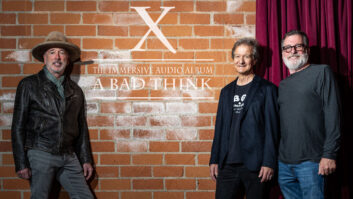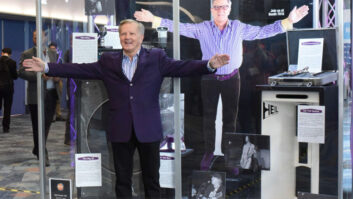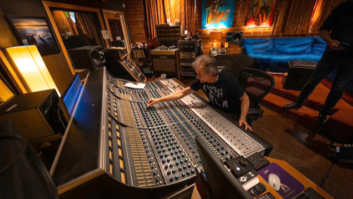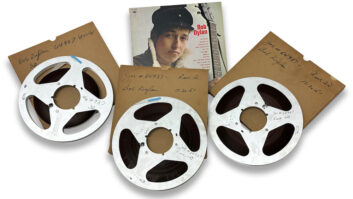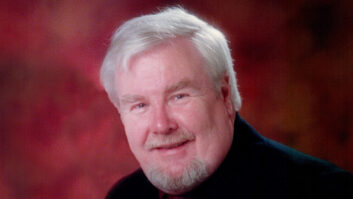Bob Clearmountain’s success as a mix engineer through the yearshas led to a string of plum production assignments. By the early’90s, he’d earned production points with The Pretenders, Hall& Oates, Bryan Adams and about two dozen other high-profileacts. But the artistic and financial rewards didn’t balance out thehassles, and so Clearmountain decided to stick to mixing. Until heheard the music of singer/songwriter Jonatha Brooke, who had madeher initial splash as co-leader, with Jennifer Kimball, of TheStory.
Brooke enlisted Clearmountain to work on 10¢ Wings, thealbum preceding her current release, Steady Pull. “The recordhad been mixed,” says Brooke, “but it wasn’t poppingout of the speakers. After Bob worked on it, every single word ofthe vocals could be heard, the record had bottom end for days, andit all fit together.”
Mixing involves more than knowing how much reverb to apply to asnare. His musicality is what made Brooke eager to work withClearmountain. “Bob has a great ability to weed outextraneous material. We had a song on the earlier album called‘Secrets and Lies,’ which featured an accordion part inthe chorus. I kept wondering if it was corny, but Bob immediatelywent to that part, pulled it up in the mix and weeded somethingelse out of the mix that was getting in its way.” Brooke’sdesire to work with Clearmountain was later reciprocated. When shehad enough material for another album, she dropped in at Mix This!,Clearmountain’s home studio, to let him have a listen. What madeClearmountain, who has his pick of high-paying mix assignments,decide to co-produce Steady Pull on spec?
“Jonatha’s an amazing songwriter,” he says.“She’s like Aimee Mann, in that instead of writing a song andleaving it at that, she keeps working, taking her pieces severalsteps further. She’ll come up with a good lyric and changes and askherself what can be done to take things further.”
Her writing may not fit snugly into radio playlist formats,though. Occasionally compared to the young Joni Mitchell, Brooke’swork is part pop but part art song, as well. Structures evolverather than repeat, literally. Even choruses may appear withdifferent numbers of bars. All of her songs are anchored byBrooke’s first-rate guitar work, which often draws on tunings ofher own devising. “Jonatha’s tunings are very unique,”says Clearmountain. “They make for unusual inversions, andshe uses her remarkable voice to lay melodies over her guitar partsin unusual ways.”
Brooke and Clearmountain wanted Steady Pull to have a live feel,so they set up a drum kit in the lounge area of Mix This! andtracked guitars, guide vocals and drums in a single pass on many ofthe songs. “The first thing we did on each track was work thevocal,” says Clearmountain. “We would never record anoverdub without listening to her vocal and making sure that partswould complement her singing. When you’re working with asinger/songwriter like Jonatha, it’s important to remember that allof the writing revolves around the voice, and that the mixer’s mostimportant job is to keep things out of its way. Anything thatconflicts, or clouds over the singing, I dip frequencies on or takeout completely. It’s easier to make those kinds of decisions whenyou’re co-producing a record rather than simply mixingit.”
Brooke says that Clearmountain’s ability to get great soundsquickly is one of the most enjoyable aspects of his talent.“We wanted to keep the live feel of what band performancesare like, playing rather than refining parts ’til the end oftime. Sure, you know that drum sounds will be worked on in the mix.But Bob would bring up the drums in a matter of minutes while wewere rehearsing, and they sounded great! The sound inspired us toplay our best.”
Contrapuntal compliments seem to be in order when either Brookeor Clearmountain is asked about the other. “Let me give youanother example of just how extraordinary Jonatha is,” saysClearmountain. “She speaks French and thought that recordingFrench vocals on some of the tunes would be fun and might helpsales in Canada and Europe. She came in one afternoon and sang allof the lead and background vocals in French on four songs, nearlyperfectly. She’s got an amazing control over all of her techniques;writing, singing and playing.”
Mix This! revolves around Clearmountain’s SSL G+ console.“It’s a 72-input board that’s been customized quite abit,” he says. “Lots of little things, mostly. I put inan in-place solo system for the VCA group faders and added some busfeatures that make mixing a little easier. We’ve got an extrastereo cue send and a rotary master fader, which I find easier touse than a standard fader.”
What new toys is Bob Clearmountain using these days? “Thecoolest thing I can see these days is the Apogee stereo mic pre. Itsounds unbelievable. It has a slot on the back where you can put an8-channel D/A, which lets you use it as a front end to Pro Tools,ADAT or DA-88. The mic pre sounds gorgeous. We recorded all ofJonatha’s vocals through it. The Avalon M5 mic pre is alsoexcellent, as is their U5 direct box, which we used a lot on thisrecord. But I keep coming back to the Apogee converters. Everyone’slooking for warmth in their digital recordings, and we’re getting alot of comments that Steady Pull is a very warm-sounding record,even though it was recorded entirely in the digital realm. A lot ofthat has to do with the Apogee converters.”
Surround mixing is all the rage, but Clearmountain approachesmultiple speaker setups with caution: “We mixed the record insurround, using five KRK E7s.” Five speakers? Where’s the .1?“I don’t use a subwoofer,” he says. “I’m nervousabout putting things into it. I’d use a sub if there wereexplosions on the record; that’s about it! You don’t know howpeople are going to be hearing the work once you start getting intothese frequency areas. Suppose someone has just watched aSchwartzenegger movie on their surround system and has cranked upthe sub to get juiced by all of the sound effects. Then they put onour record. It would sound terrible! I feel that I have morecontrol and can be more certain that the listener will hear themusic the way we intended it to be heard. I leave out thesub.”
Project studio mixers take heart. Like you, Bob Clearmountainruns out of faders. “Working in surround requires morefaders,” he notes. “The surrounds are separate and inaddition to the stereo mix. I use the small faders on the G Seriesas sends to the surround matrix. In the past, I’ve normally usedthem for echo returns, which means that I run out of echo returnsreal quick. We solved the problem by bringing in an O2R, simply tobe used as a static mixer.
“The interesting thing about surround sound — whichI think a lot of people don’t realize — is that there isn’tone way to go about handling it. Effective use of surround dependson the type of music you’re working on, the specific song andhaving a clear understanding of the effect you’re trying toachieve. Tricks may be fun to play with in your studio, but arethey advancing the idea behind the music?”
Clearmountain exploited surround mixing on one track inparticular, Brooke’s “How Deep Is Your Love.”“Jonatha recorded multiple vocal passes, and we decided totreat them like an amusement park ride,” he says. “Thebackgrounds bounce all over the surround matrix. Maybe we tookthings over the top a little, but it’s fun to listen to. That’swhat listening to records is all about to me.” In general,though, less is more is the advice Clearmountain would give hiscolleagues when it comes to surround mixing. “Creatingambience, using reverb to expand the field; that’s great. Possiblyusing room mics on the drums and mixing them a little wider, that’salso good. To tell you the truth, though, I haven’t mixed that muchin surround. Lots of times we’ll start out thinking surround. ThenI’ll go back to the stereo mix and find that I like it better. Iask myself, ‘What’s the point?’ Again, any time youmake any decision as a mixer, the question is, did it enhance thesong? That’s not to say that there aren’t situations where surroundis perfect. If I was mixing a Pink Floyd record, I’d go heavilyinto surround. But I wouldn’t if I was mixing a Bruce Springsteenrecord. Wait a minute — I am mixing a Springsteen record nowin surround! But that’s different. It’s a live record, and we’resimply sending the hall into the back speakers. I’m not using asubwoofer on that one, either. The only time I’ve used a subwooferto date was on a live Bryan Adams record, a concert at Slane Castlein Ireland, and the only reason we used the sub was that there werefireworks at the end of the show!”
When we spoke, both Clearmountain and Brooke were lookingforward to the release of Steady Pull on Mad Dog Records, scheduledfor February 2001. Meanwhile, Clearmountain is dealing with awelter of high-profile mix assignments, while Jonatha Brooke isallowing herself a moment to enjoy the taste of artisticfulfillment. What’s next for her? “I don’t know what willcome out next,” she says. “I haven’t been in a writingmode lately. As a side project, I’d like to explore ambient music,using weird, unidentifiable sounds. I’d also like to make a chamberrecord, using a string quartet to accompany all of the waltzes I’vewritten over the years — not traditional waltzes, but piecesin three. Right now I’m loving this record!”
Those interested in finding out more about Bob Clearmountain andhis studio are invited to visit his Web site at www.mixthis.com.

